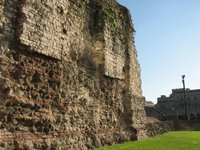Belgravia and Knightsbridge
Today I went on a guided walk of Belgravia and Knightsbridge, the "posh" section of London, ie bloody expensive! Belgravia was developed in the 1820s throughout the Victorian era as houses for aristocrats and is still one of the more popular areas in the city for posh people to live. Actually all of Belgravia is owned by one man, the Duke of Westminister, and people lease from his estate. Obviously the guy has a lot of cash!!! Until the recent arrival of the Russian exiles, he was the wealthiest man in Britain, now number four I think. (Side not, the current Duchess has been known to feud with Camilla and the current Duke recently was caught by a tabloid, "entertaining" call girls!) Knightsbridge is, of course, home to Harrods. Lots of famous people lived in both areas, so blue plaques everywhere, so my pictures are mainly of a few of their houses.
 St. Saviour's Church, in Belgravia
St. Saviour's Church, in Belgravia
 The Cadogan Hotel in Knightsbridge- this is where Oscar Wilde was arrested
The Cadogan Hotel in Knightsbridge- this is where Oscar Wilde was arrested
 Chester Square, really expensive and exclusive block to live in. The house halfway down with the silver sedan in front of it, is where Margaret Thatcher currently lives. Houses in Chester Square usually go for about 40 to 60 million pounds for a 45 year lease!
Chester Square, really expensive and exclusive block to live in. The house halfway down with the silver sedan in front of it, is where Margaret Thatcher currently lives. Houses in Chester Square usually go for about 40 to 60 million pounds for a 45 year lease!
 St. Saviour's Church, in Belgravia
St. Saviour's Church, in Belgravia The Cadogan Hotel in Knightsbridge- this is where Oscar Wilde was arrested
The Cadogan Hotel in Knightsbridge- this is where Oscar Wilde was arrested Chester Square, really expensive and exclusive block to live in. The house halfway down with the silver sedan in front of it, is where Margaret Thatcher currently lives. Houses in Chester Square usually go for about 40 to 60 million pounds for a 45 year lease!
Chester Square, really expensive and exclusive block to live in. The house halfway down with the silver sedan in front of it, is where Margaret Thatcher currently lives. Houses in Chester Square usually go for about 40 to 60 million pounds for a 45 year lease!












.jpg.jpg)



.jpg.jpg)

.jpg.jpg)
.jpg.jpg)












